MARIANI’S
Virtual
Gourmet
July 5 ,
2020
NEWSLETTER
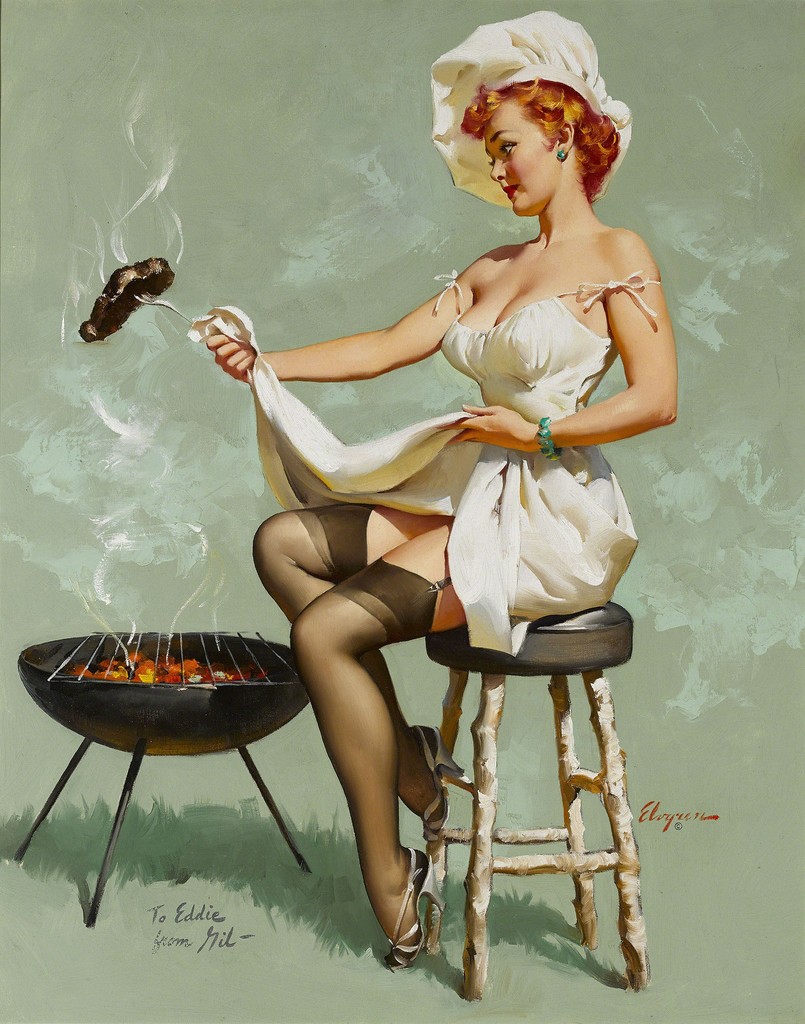
Gil
Elvgren
IN THIS ISSUE
MONET'S GIVERNY
By John Mariani
NEW YORK CORNER
LOVE AND PIZZA
CHAPTER FIFTEEN
By John Mariani
NOTES FROM THE WINE CELLAR
RED AND WHITE SPARKLERS FOR SUMMER
By Geoff Kalish
❖❖❖
GIVERNY
By John Mariani
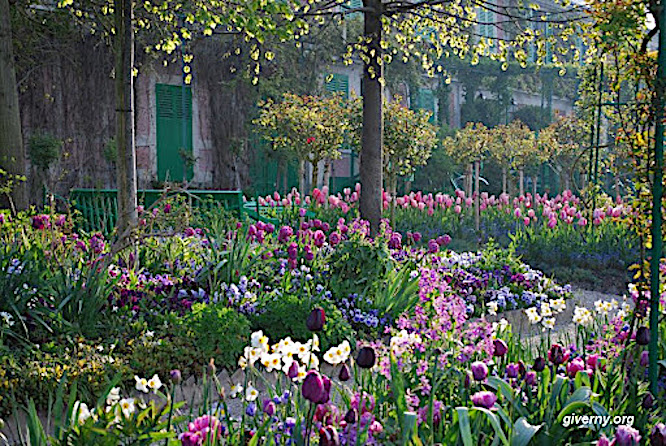
I
was planning to write about Giverny in the
Seine Valley at the end of winter, in anticipation
of the town blooming in the springtime. But with
France in lock-down that seemed pointless. Now,
with France out of lock-down and summer in full
swing, I can happily report on this uniquely
beautiful little town, where the artist Claude
Monet created his own Garden of Eden to inspire
him for 43 years (1883-1926).
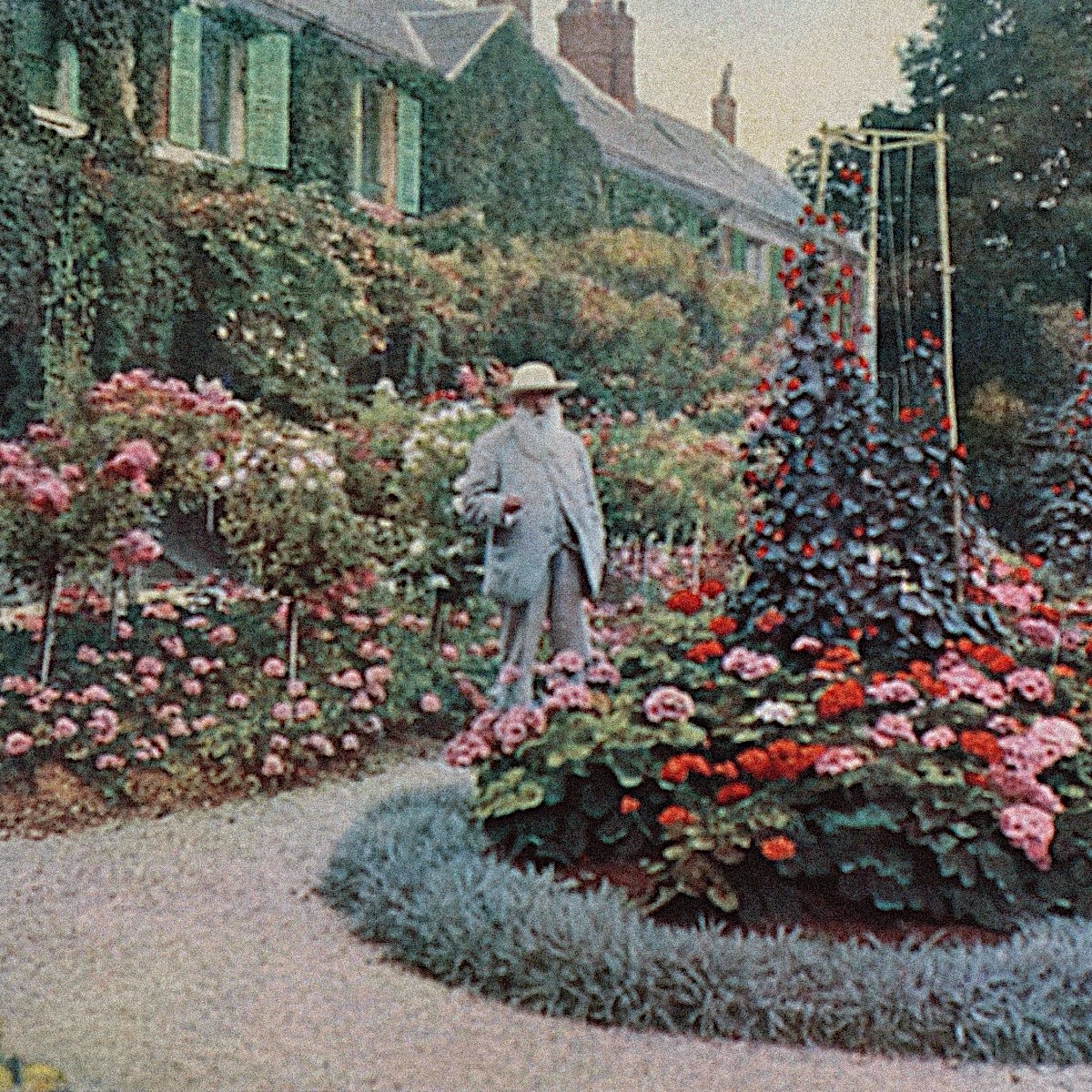 Monet’s Giverny presents
the eternal question: Does art copy Nature or Nature
copy art? In the case of Monet, perhaps the most
beloved of the French Impressionists and certainly
the best known, those who have never visited his
home and gardens already know it through his
paintings so that when one does visit one is likely
to remark on how Nature has fitted itself to Monet’s
conception of it.
Monet’s Giverny presents
the eternal question: Does art copy Nature or Nature
copy art? In the case of Monet, perhaps the most
beloved of the French Impressionists and certainly
the best known, those who have never visited his
home and gardens already know it through his
paintings so that when one does visit one is likely
to remark on how Nature has fitted itself to Monet’s
conception of it.
The artist planted and weeded the
garden himself, once saying, “Beyond painting and
gardening, I am good for nothing.” When he painted,
he allowed no visitors: “When I work, if I am
interrupted, I lose all inspiration, I am lost. You
understand easily, I am chasing a band of color.” He
expended all his energies on capturing “a maximum of
appearances, in straight correlation with unknown
realities.” As for his famous water lilies, he
exulted, “It took me some time to understand my
water lilies … I cultivated them with no thought of
painting them … One does not fully appreciate a
landscape in one day … And then, suddenly, I had a
revelation of the magic of my pond. I took my
palette. From this moment, I have had almost no
other model.”
There is an order to the gardens,
but none of the formality of a wealthy French estate. Today it is tended
with the same care a conservationist would expend on
restoring a Monet painting, and the house and its
interior look just as they were the day he died.
French estate. Today it is tended
with the same care a conservationist would expend on
restoring a Monet painting, and the house and its
interior look just as they were the day he died.
Marcel Proust found that Monet’s
garden lay-out was done so that “Flowers [are]
displayed together but not as nature because they
were sown so that only flowering at the same time as
matching shades, harmonized to the infinite in all
ranges of blue or pink. This powerfully manifested
painter’s intention in one sense dematerialized from
anything but color.”
The species seem endless: Babylon
willows, ferns, kalmias, rhododendrons, azaleas,
holly, roses, water lilies, bamboo, butterbur,
thalictrums, wisterias, tamarask and many more.
Monet said he merely “took a catalogue and chose at
random, that’s all.”
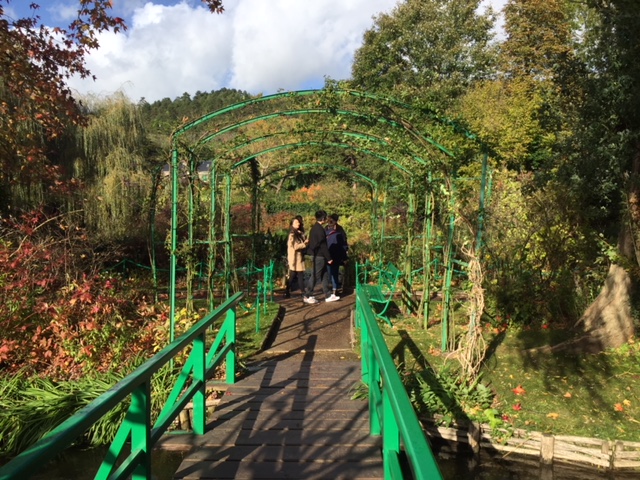 The
charming, childlike green bridge is there, which he
painted from many angles and is the most
identifiable non-natural object in the garden. To
cross it makes one feel right at the center of the
Impressionist art movement, surrounded by moving
foliage, scudding clouds and a pond teeming with
life.
The
charming, childlike green bridge is there, which he
painted from many angles and is the most
identifiable non-natural object in the garden. To
cross it makes one feel right at the center of the
Impressionist art movement, surrounded by moving
foliage, scudding clouds and a pond teeming with
life.
The house is of good size and
very intimate, sun-filled colorful but without much
to indicate that Monet lived there. There are some
Japanese prints on the walls, comfortable furniture,
a splendid yellow dining room (below) and a
big kitchen in blue and white tiles. The artist was
a lover of country fare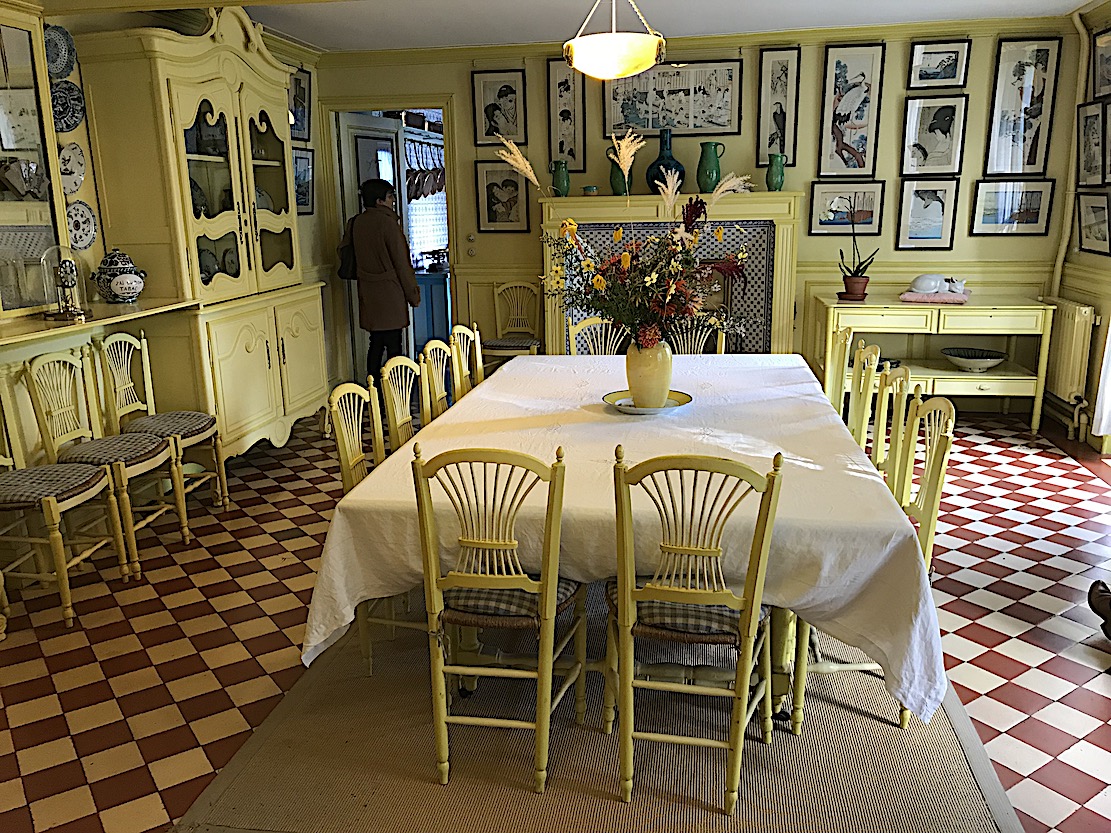 and
generous to his guests when invited to lunch,
serving them hors-d’oeuvres with “the best Norman
butter,” succulent sweetbreads with spinach, two
chickens for five people, then a fruit tart.
and
generous to his guests when invited to lunch,
serving them hors-d’oeuvres with “the best Norman
butter,” succulent sweetbreads with spinach, two
chickens for five people, then a fruit tart.
The area of Giverny itself is
very beautiful most of the year, and the Musée des
Impressionisme is nearby. Driving up to Monet’s
gardens on a narrow road is pretty enough but
parking is very difficult to find in the high
season. If you’re staying overnight, it would be
best to park at the hotel, which Giverny has plenty
of, aside from a score of B&Bs.
The only three-star hotel is La Chaine D’Or
(25 Rue Grande, Les
Andelys; +33 2 32 54 00 31), which is
elegant but not overly fussy and coalesces nicely
with its rural countryside. One of the best known
and most popular—and just steps away from the Monet
Foundation—is the Hotel Baudy (81 Rue de
Monet; +33 2 32 21 10 03), which had been on
its site long before 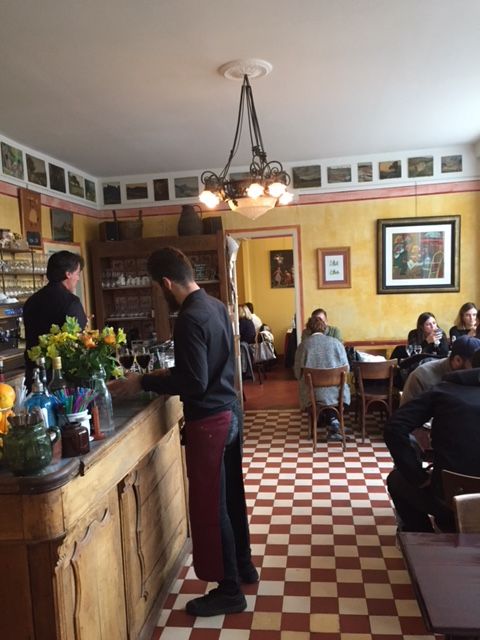 Monet arrived, but after a
renovation in 1891 it became the favorite of artists
visiting from all over the world, whom the owners
courted by placing an atelier to work in on the
first floor. It also has a delightful bistro in a
town with not many of them, and it looks remarkably
like it did in the 19th century, with a brick-walled
epicérie adjunct.
Monet arrived, but after a
renovation in 1891 it became the favorite of artists
visiting from all over the world, whom the owners
courted by placing an atelier to work in on the
first floor. It also has a delightful bistro in a
town with not many of them, and it looks remarkably
like it did in the 19th century, with a brick-walled
epicérie adjunct.
Our sun-filled lunch at Baudy was
all I could wish it to be and evocative of the kind
of food Monet himself enjoyed. We began with a
silken carpaccio of pink salmon with chives and
crème fraîche; a hearty terrine of chicken livers; a
vegetable potage that reminded me of my 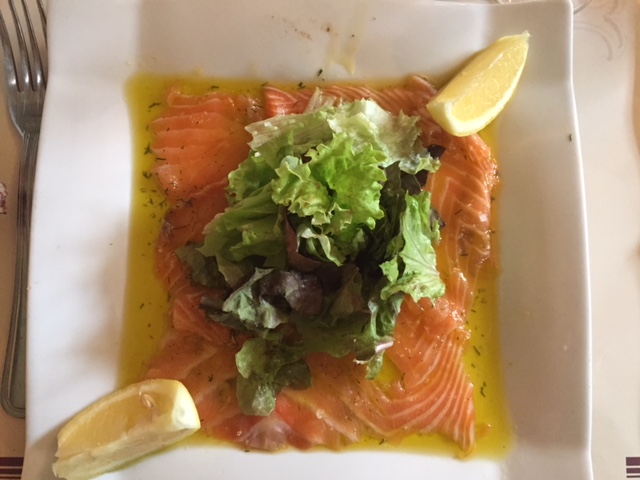 French mother-in-law’s
delicious soups; a crêpe of oozing, rich Camembert
the color of ivory; Baudy’s signature oven-baked
apple tart with frangipane, caramel and vanilla ice
cream; perfect, warm profiteroles au
chocolat; and a pichet of
local vin
rouge. Prices are very reasonable, with a 32
euro menu that’s a steal.
French mother-in-law’s
delicious soups; a crêpe of oozing, rich Camembert
the color of ivory; Baudy’s signature oven-baked
apple tart with frangipane, caramel and vanilla ice
cream; perfect, warm profiteroles au
chocolat; and a pichet of
local vin
rouge. Prices are very reasonable, with a 32
euro menu that’s a steal.
The walls
are an ochre yellow with high wainscoting,
tablelcoths the color of Burgundy wine or pink
roses, an old upright piano in the corner, and a
lively bar up front. The service staff is fleet of
foot and very cordial, and the rush of the room is
part of its vitality, though you’ll never be asked
to hurry up. Booking in advance at both the hotel
and restaurants is highly advisable.
IF YOU GO, PLAN
AHEAD
Monet's house and
gardens welcome visitors everyday, including public
holidays, from 9:30 a.m. to 6 p.m. Open till
November 1.
Normal fare and seniors: 11.50 euros. Children
and students: 7.50 euros.Due to the Covid-19
pandemic, tickets are for individual visitors only
(up to 10 people). Tickets are not for sale on site.
E-TICKETS
ARE MANDATORY.
❖❖❖
By John Mariani
LOVE AND PIZZA
Since, for the time being, I am unable to write about or review New York City restaurants, I have decided instead to print a serialized version of my (unpublished) novel Love and Pizza, which takes place in New York and Italy and involves a young, beautiful Bronx woman named Nicola Santini from an Italian family impassioned about food. As the story goes on, Nicola, who is a student at Columbia University, struggles to maintain her roots while seeing a future that could lead her far from them—a future that involves a career and a love affair that would change her life forever. So, while New York’s restaurants remain closed, I will run a chapter of the Love and Pizza each week until the crisis is over. Afterwards I shall be offering the entire book digitally. I hope you like the idea and even more that you will love Nicola, her family and her friends. I’d love to know what you think. Contact me at loveandpizza123@gmail.com
—John Mariani
To read previous chapters go to archive (beginning with March 29, 2020, issue.
LOVE AND PIZZA
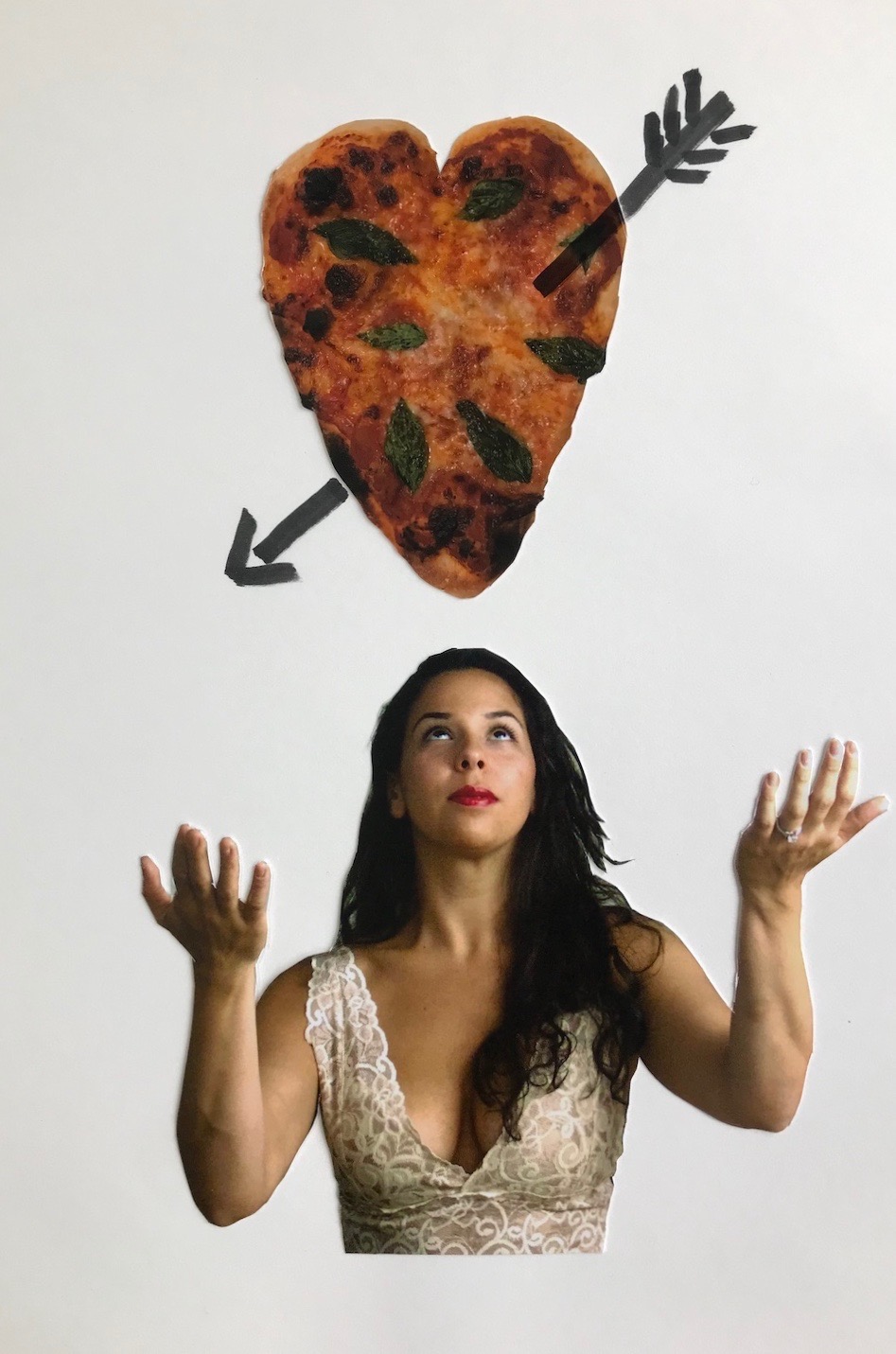
Cover Art By Galina Dargery
CHAPTER FIFTEEN
Nicola
and Catherine went back to their dorm
room giddy from the Champagne and from all that
had just occurred. Throwing herself on the
bed, Nicola
said, “I cannot believe this is happening,”
then, “Oh, shit,
I’m
going to have to cut class tomorrow.”
“For Chrissakes,” shouted
Catherine. “You
barely cut any classes all semester and you
already told me you’re caught up on
everything.
Damnit, Nicky, don’t
worry about it. You drive me crazy.”
Nicola said, “I guess it’ll be
okay,” then
snapped her fingers. “Catherine, what if Signora
Palma hired you
to model too?”
“Nicky, I look about as Italian
as Meryl
Streep,” somehow managing to turn a moment of
candor into a pat on her own
back.
“I bet Meryl Streep could play
an Italian
better than most Italians,” said Nicola, laughing.
“Yeah, well . . .”
“Hey, maybe they can put you in
a wig and maybe
you’ll look more like, I don’t know, Daniela
Bianchi,” referring to the
stunning blonde actress who played a Russian spy
in the James Bond movie From Russia
with Love.
“I don’t think so, but nice
try. Plus, Palma’s
got all her other models already.”
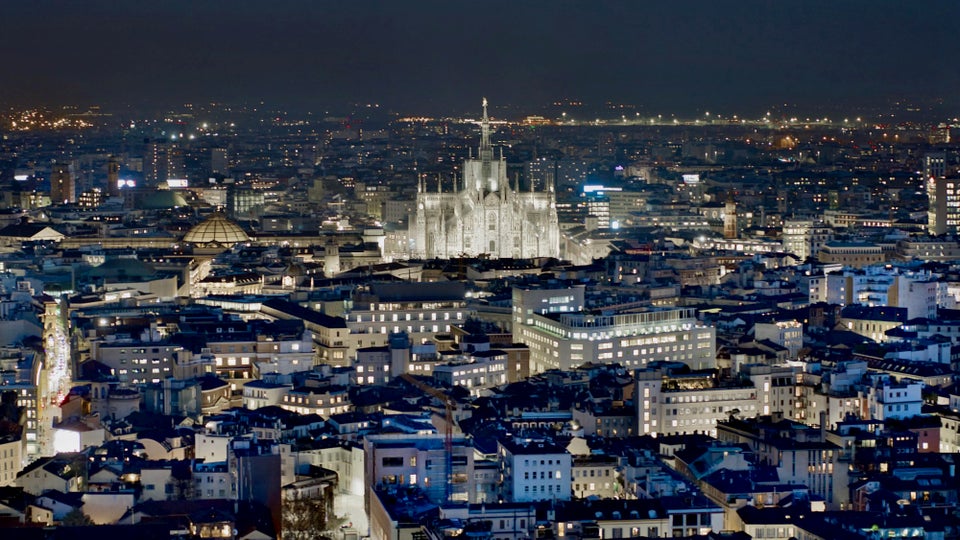 That
evening Nicola took a taxi to Signora
Palma’s studio, in the Navigli
neighborhood, for a fitting that lasted about two
hours. Nicola
tried on three ensembles: two dresses,
one with a low v-neck, the other
scoop necked, both with flared sleeves, and one
Capri pants outfit with a
richly colored print blouse that buttoned low,
with hoop earrings and gold
mules. She
put on a bob wig and
they also did her own hair so as to have it tall
atop her head and dropping
down behind her ears to her shoulders. With each
hairdo and outfit Nicola
donned a different headband, and each time Signora
Palma would just sigh and say, “Mia nuova
Claudia! Molte bella, tante bella!”
That
evening Nicola took a taxi to Signora
Palma’s studio, in the Navigli
neighborhood, for a fitting that lasted about two
hours. Nicola
tried on three ensembles: two dresses,
one with a low v-neck, the other
scoop necked, both with flared sleeves, and one
Capri pants outfit with a
richly colored print blouse that buttoned low,
with hoop earrings and gold
mules. She
put on a bob wig and
they also did her own hair so as to have it tall
atop her head and dropping
down behind her ears to her shoulders. With each
hairdo and outfit Nicola
donned a different headband, and each time Signora
Palma would just sigh and say, “Mia nuova
Claudia! Molte bella, tante bella!”
Nicola missed dinner, which she
considered a
blessing, and went back to her dorm very tired. Catherine was in bed reading
for a class.
“So how’d it go?” she asked,
slapping the
textbook shut. “Tell me every detail.”
“I don’t know,” replied Nicola.
“She said it
went very well. With the short wig and the
headband, I guess I can look a
little like Claudia Cardinale. It
was fun. I
think I could get used
to being pampered.”
Catherine lay back in bed and
said, “Wait till
they hear about this in
the Bronx.”
Nicola went into the bathroom
and began
cleaning off the make-up they’d applied at the
studio. But
she left the dark eyeliner and
mascara on, winking in the mirror and smiling,
liking the way she looked.
Tomorrow she would write home
with the news. If
she had time.
But tomorrow was to begin at
four a.m. and would likely go
till midnight. Nicola got
little sleep, thinking about the day ahead. She
had put her alarm clock under
her pillow, hoping it would not wake Catherine. When it did go off, sounding
more like muffled clicking,
Nicola had already been awake for a while, after
dreaming that she was back
home at Bella Napoli eating pizza with Signora
Palma.
Catherine didn’t stir and
Nicola pulled herself
out of bed, wondering about what the hell she was
about to do.
In the bathroom she looked at herself
in the mirror, her hair bedraggled, eyeliner and
mascara smudged down her
cheeks, and decided she didn't look anything at
all like Claudia
Cardinale. “What
was Signora
Palma thinking?
This is going to be a disaster and I’ll
be laughed off the catwalk!” she thought,
trembling in the cold room whose heat
had not yet come up.
Signora
Palma told her not to put on any make-up, so
Nicola just washed her face—getting
rid of yesterday’s eyeliner and mascara-- brushed
her teeth, and
pulled her hair back in a
ponytail. Then
she slipped into
jeans, t-shirt and her overcoat, pulled on her
boots and put her hand on the
doorknob. Catherine stirred and without lifting
herself from her pillow, said, “Knock
‘em dead, Nick,” then slumped back to sleep.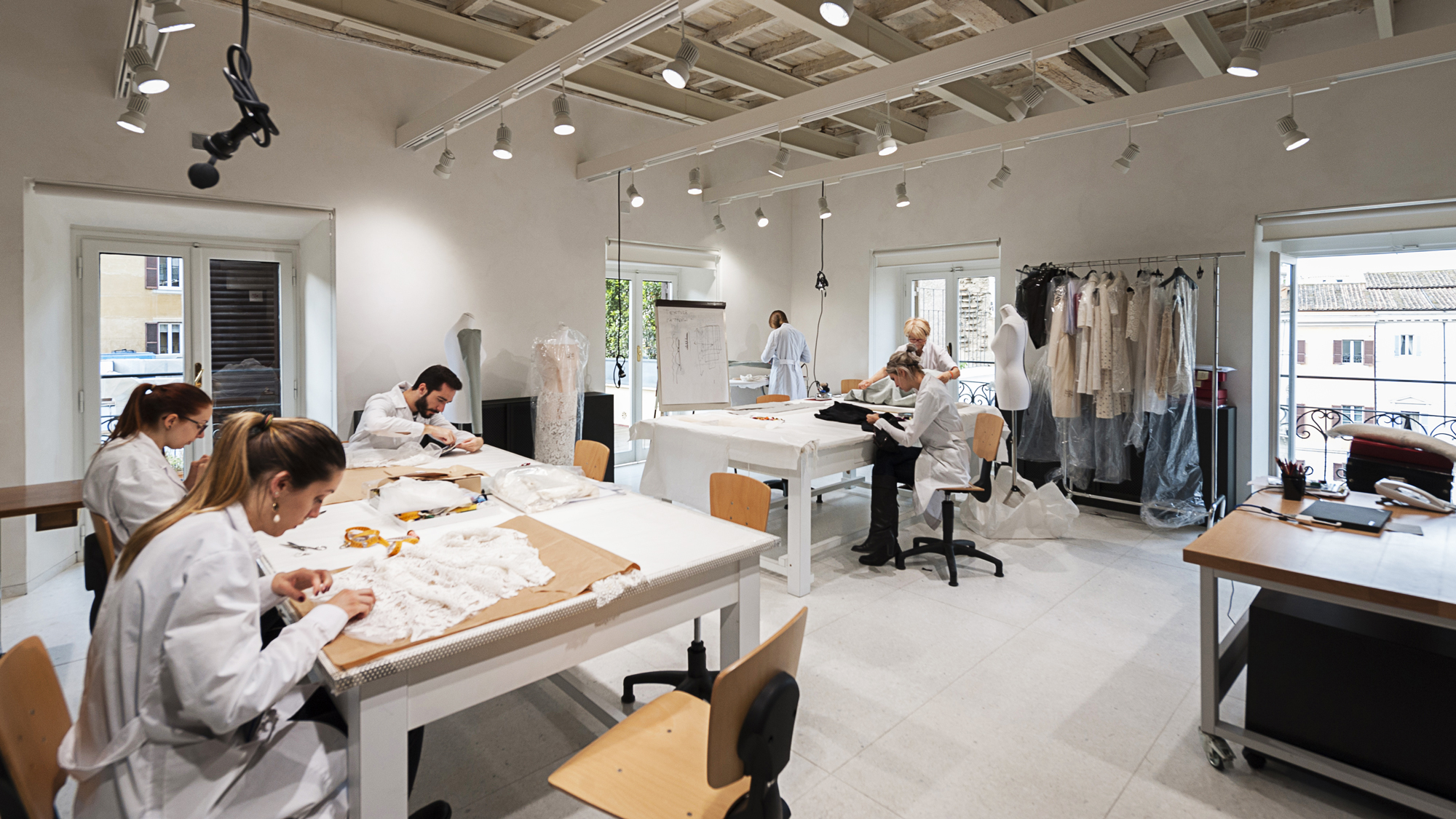
As
usual, there was a dense cold fog that
morning, a dark chilling mist that made the street
lights glow and the cars in
the street glisten.
Nicola could
not see beyond the end of the block, and there was
almost no sound at all, save
a truck way off in the distance, maybe one
delivering clothes for one of the
shows. Signora Palma had arranged for a car
to pick her up and, in a few
seconds, a
softly purring BMW
appeared as two columns of foggy light. The driver
pulled up to the curb,
rolled down the window and asked, “Signorina
Santini?”
Nicola said yes and the driver
got out and
opened the door.
They drove
quickly through the empty streets to the Navigli,
where the lights in Signora
Palma’s studio were on. The
driver opened the car door then escorted her to
the entrance of the building,
pressing a bell labeled PATRIZIA PALMA.
“Pronto?”
came a woman’s voice.
“Si, c’e
Nicola Santini.”
“Prego,
piano due.”
Without further acknowledgment
the door clicked
open, the driver returned to his car, and Nicola
walked up the steps to the
second floor, where the door was already open. It was a large, brightly
lighted room with bolts of cloth,
cutting tables, accessories in boxes,
cotton-covered mannequins stuck with
pins, a whiteboard with scribblings all over it in
various colored Dri-Mark,
the usual office paraphernalia and, stuck to a
cork wall, many photos of
Italian actresses of the 1960s in many different
outfits.
Signora
Palma was dressed in a white smock, with a
cigarette in one side of her mouth
and pins in the other.
“Ah,
Ciao, Nicola. Avanti,
avanti. You
need una
caffé?”
Nicola accepted the offer and a
male assistant
she’d met the day before went over to an espresso
machine and made her a strong
double, offering her sugar, which she refused.
“Allora,”
said Signora
Palma, laughing. “You
look like Cardinale when she get out of bed! We
fix everything.”
With that, she began to issue orders to the
staff, which included those Nicola had met at
Bagutta, all looking like they’d
already consumed a great deal of espresso. There
were also two seamstresses,
and two or three others whose jobs there were not
yet clear, though Signora
Palma asked them to do this or
that. There
were as yet no other
models there.
“Where are the other girls?”
Nicola asked the
woman she’d met the day before at Bagutta—named
Maria—again in black turtleneck
and black jeans.
“They’ll be here soon. Signora she want to work first with
you.”
“That’s certainly
understandable.”
Then Maria drew Nicola close to
her and said,
in very good English, “Listen, Nicola, I’m sure
you see that La Signora
can get a little
crazy, eh? Don’t let it bother
you. It’s always like this at all the ateliers and
fitting rooms this
week. Everybody
is just out of
their minds with work and worry.
But you”—Maria
winked—“saved La Signora’s—what
do you say?—ass, and
she’s going to try—I said try—to be
very nice today.”
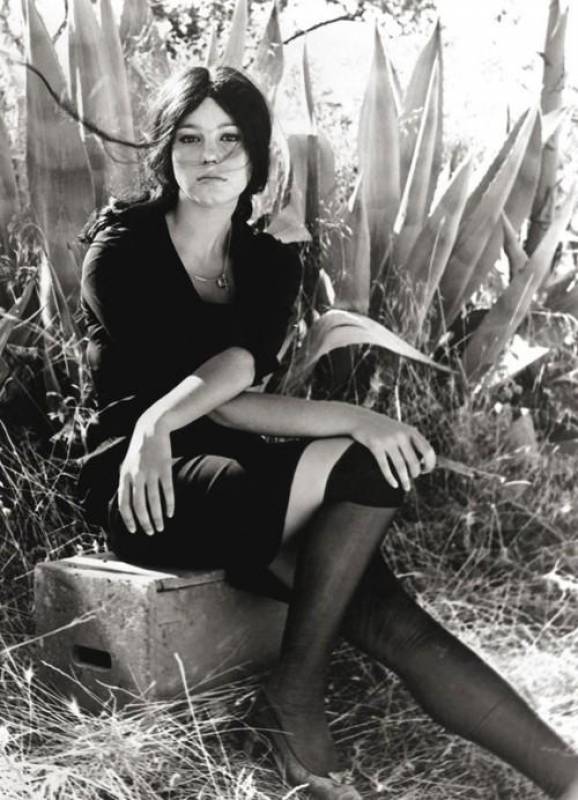 “I
appreciate that,” said Nicola. “So, what
should I do?”
“I
appreciate that,” said Nicola. “So, what
should I do?”
“Okay, first we do make-up.
Then we try on the
clothes, then we do final make-up again, then we
get ready for the show.” Maria turned to a young man
dozing in a
canvas chair, “Ricardo, andiamo,
Signorina Cardinale e ecco!”
Ricardo,
who was apparently the make-up fellow,
blinked, stretched his arms and looked at Nicola.
With his spiked hair, he wore
an unbuttoned, wildly flowered shirt with a
sleeveless t-shirt underneath.
“Hm,” he said, “you do look like Claudia ...
a little. We going to have fun.
Io
sono uno maestro!”
Signora
Palma shot him a look, pointed to her watch and
said, “Okay, Maestro, andiamo sta
giorno, per favore?”
The other
models began arriving—four
of them, each
chosen for their resemblance to an Italian movie
star, which Nicola did not see
at first. All
were about Nicola’s
height and weight, none of them wraith-like in the
manner of other models she’d
seen in Milan.
Two were Italian,
another—a blonde who did resemble Stefania
Sandrelli (left)
a little—was French, and
another blonde—Virna Lisi? (below)—was
German.
All spoke a little English, the German
fluently, and although all of them were tired
from runway jobs the day before,
they seemed friendly enough and did not to
appear overly competitive to Nicola,
whose background they did not know.
Nicola felt
completely out of place but enjoyed the make-up
part of the morning, which gave
her a basic foundation and some eyeliner. 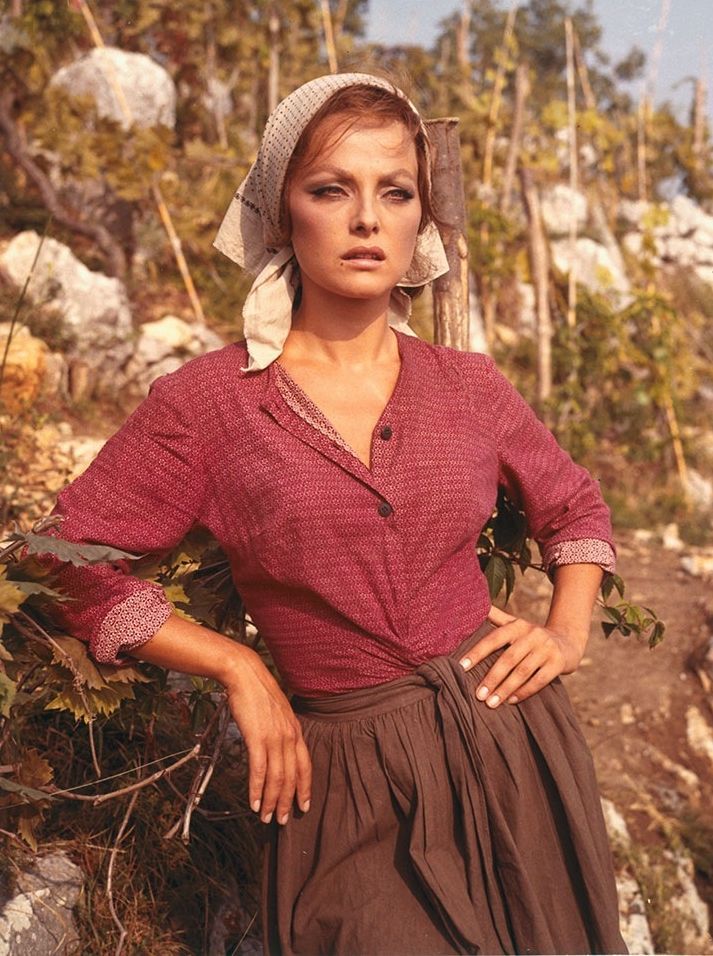 False
eyelashes would come later, then the hair and
clothes. By
eight o’clock everything seemed to
be going well, though Signora
Palma
was becoming more frantic, frequently asking what
time it was, lighting
cigarettes then just as quickly putting them out. She kept asking questions
that had already been answered.
False
eyelashes would come later, then the hair and
clothes. By
eight o’clock everything seemed to
be going well, though Signora
Palma
was becoming more frantic, frequently asking what
time it was, lighting
cigarettes then just as quickly putting them out. She kept asking questions
that had already been answered.
The
show would begin at eleven, just three hours to
go. By eight-thirty, with the
first application of make-up, Signora
Palma’s movie stars were
emerging from the faces of the girls she’d chosen: Sophia Loren, with her proud
cleft chin, lynx-like eyes and
huge, irresistible smile; Gina Lollabrigida, with
her angled eyebrows, high
cheekbones and gypsy-like southern fire; Virna
Lisi, with silky blond hair like
Marilyn Monroe’s, the slightly parted lips, and
her bedroom eyes; Stefania
Sandrelli, seemingly so innocent but erotically
charged, with a face that could
bring a priest in confession to sin; and Claudia
Cardinale, with that childlike
pout, eyes of a sea siren, faint dimples, and an
impenetrable
mane of hair that could smother a man.
What seemed to Nicola to be
total chaos was
actually a form of frantic, desperate control. Everyone had his or her job,
or several jobs, and a stylist
would flit from one model to another while a
technical assistant might be
downstairs fixing the sound system one minute and
upstairs fixing a sewing
machine the next.
Plastic bags
that held the outfits were everywhere, wigs were
mounted on Styrofoam heads,
shoes were arrayed along one wall and numbered to
coordinate with the outfits,
and the espresso machine never stopped working.
At first Nicola was very
nervous about standing
in her underwear amidst all the activity, but none
of the males rushing through
and about the studio gave her or the other models
so much as a glance. Nicola decided they were
either all gay
or too terrified by Signora
Palma to
ogle her girls.
The other models took
everything in stride—even
if they were only veterans of perhaps a single
season—effecting a look of total
boredom, smiling only when they were finished with
make-up or allowed a
five-minute cigarette break. They
yawned constantly. For the new girls in town
Fashion Week could make or break
their fledgling careers, and although there were
plenty of opportunities for
them to work and be seen—with more than a hundred shows
posted by the fashion trade group Camera
Nazionale della Moda Italiana—the
competition was fearsome and getting
noticed by the top designers,
editors and photographers by trying to appear
something like what the designers
had in their heads made the idea of standing out
nearly impossible.
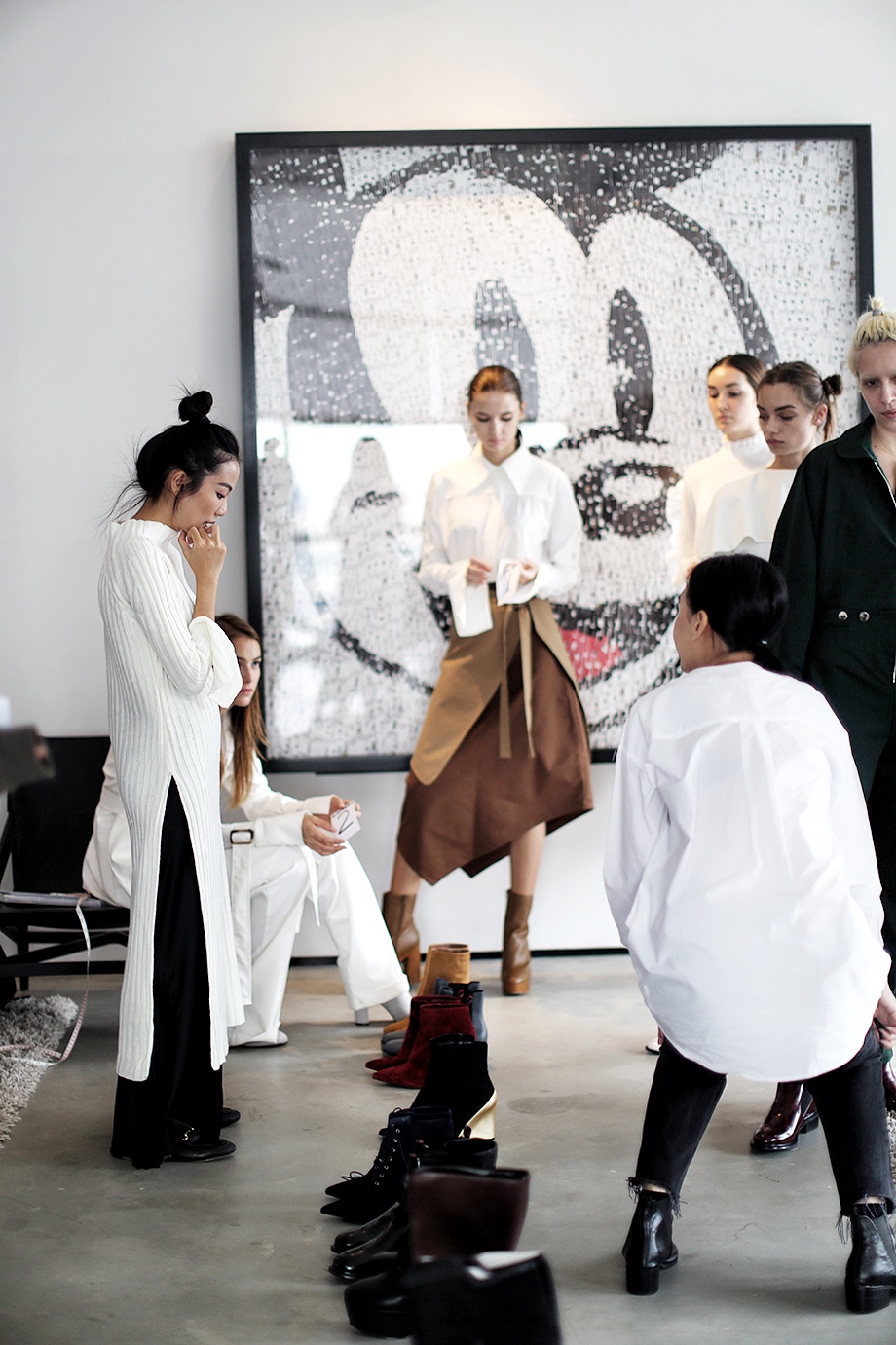 Still,
the possibilities were far better for
the neophyte models in Milan than in Paris, where
most sought-after models had
established themselves and appeared year after
year with the top
designers. Rushing around Milan to a
dozen or more casting sessions
could be a blur for both model and talent agent,
and a casting call might rip
through a list of 200 models to find just ten that
fit their agenda and
look. Usually
the girls would
arrive, hand their bulky portfolios to a
designer’s staff member, wait and then
be told thank-you and be sent on their way, not
even knowing if the designer
had even laid eyes on the portfolio, much less
getting in to be seen by him.
Still,
the possibilities were far better for
the neophyte models in Milan than in Paris, where
most sought-after models had
established themselves and appeared year after
year with the top
designers. Rushing around Milan to a
dozen or more casting sessions
could be a blur for both model and talent agent,
and a casting call might rip
through a list of 200 models to find just ten that
fit their agenda and
look. Usually
the girls would
arrive, hand their bulky portfolios to a
designer’s staff member, wait and then
be told thank-you and be sent on their way, not
even knowing if the designer
had even laid eyes on the portfolio, much less
getting in to be seen by him.
Nicola
had
gone through none of that and so had no idea just
how lucky she’d been to
be chosen out of thin air for Patrizia Palma’s
show. Whether it was pure dumb
luck or kismet, she did not know,
but it was something completely new and thrilling
in her life and she faced the
whirlwind without complaint.
Finally, at 10:45, with people
crowding into
the building’s courtyard, Signora
Palma clapped her hands loudly and an assistant
shouted, “Silenzio!” Everyone
stopped what they were doing, turned towards La Signora and listened like nuns to
their Mother Superior.
Signora
Palma cleared her throat, paused for a good ten
seconds, then speaking English
to the array of models from all over Europe, said:
“Ladies and gentlemen. We
going to do the most important show we ever done. What happens today affects
our getting into the
international market. If this show is not a big
success, this company maybe
cannot survive.
We have all worked
very hard, very very hard, for this moment. Now, let’s have a good time!
I want everybody happy! I want
the models to smile, smile big
smiles! Okay, say a prayer and go!”
At that all the models broke
into exaggerated,
big toothy smiles, but Signora
Palma’s
command was actually something of a revolutionary
exhortation, asking the
models to do the exact opposite of what was the
norm: for the standard
expression of runway models was never
to smile, never to detract from the clothes they
were wearing.
Nicola always regarded this entrenched
tradition as a way of appearing so world weary
that to show any pleasure in the
exercise would come across as being
un-sophisticated and déclassé. (Catherine
said it was because all the
European models—even Paulina Poriszkova—had bad
teeth.)
So
Signora
Palma’s command to smile was something very much
out of the ordinary, an
extension of her Italian actress theme based on
how those women brought such
joy to people’s lives simply by smiling.
She insisted that French actresses—Deneuve,
Capucine, Signoret, Adjani— never smiled,
always glum, always
killing themselves for love. Only
Bardot smiled onscreen and when she did, it lit up
the movie theater.
FOR SUMMER
By Geoff Kalish
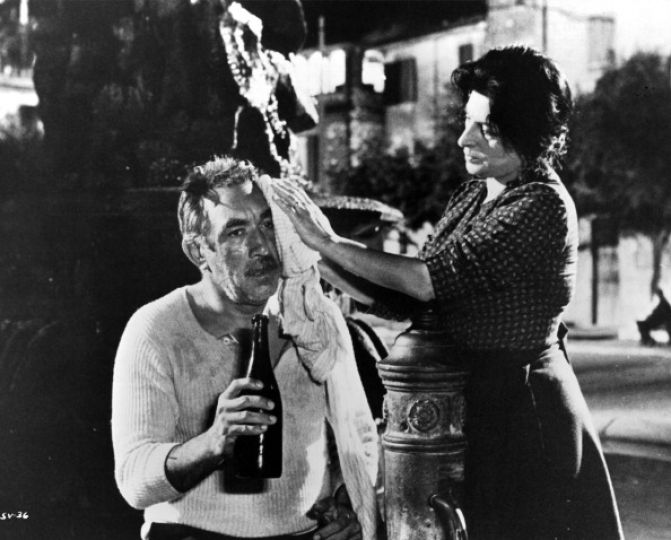
Quite often the typical food
served in a
season dictates the wine required as a mate. For
example, in the fall game
birds, often served with wild rice and
Thanksgiving turkey, with its cranberry
sauce and stuffing usually call for full-bodied
wines like heady Zinfandels and
concentrated California Pinot Noirs to match the
flavors of the fare. And stews, braised brisket
and legs of
lamb often served in winter generally benefit
from the black-currant taste and
touch of tannin in many Cabernet Sauvignon-based
wines. Similarly, simple
summertime, typical American fare like
hamburgers, hot dogs, chicken wings, grilled
skirt steak and skewered shrimp, beckon for
easy-drinking, fruit-forward
vibrant wines - especially those lacking
astringent tannin. In fact, young Cabernet
Sauvignon-based
wines often taste bitter when consumed with the
likes of hot dogs and wings. And
many Pinot Grigios and inexpensive Sauvignon
Blancs seem bland even with
barbecued shrimp. So, based on a number of
recent tastings and past experience,
the following choices are offered as guidance on
choosing modestly-priced,
widely-available wines to mate with classic
American warm weather fare.
 WHITES
WHITES
Gai’a Monograph
Assyttiko 2019 ($16)‒This bone-dry wine
was made from grapes grown
on over 10-year old vines grown in mountainous
calciferous soils in Koutsi, Nemea
(in the northern portion of Greece’s Peloponnese),
with fermentation and aging
in stainless steel. It shows a bouquet of
honeysuckle and sweet melons and a
citrusy taste with a lively finish. Its great with
grilled mild
fish like branzino and snapper as
well as chicken breasts.
Jean-Marc Brocard
Chablis 2019 ($20)‒This perfect
wine to accompany shellfish was
made from grapes grown in a south facing vineyard
noted for classic Chablis
soil containing limestone and fossilized marine
life. Following harvest,
fermentation with native yeast and 9 months of aging took place
in stainless steel tanks. It has
a very lemony bouquet and taste with hints of
honey in its crisp finish.
Estate Lorenzi
Chardonnay (Dijon Clone
76) 2017 ($48)‒After fermentation this
wine was aged in a
combination 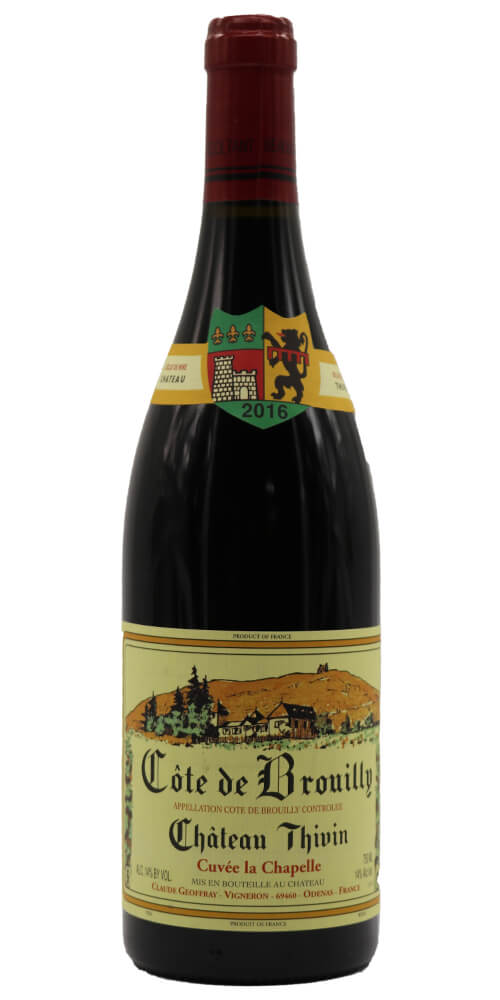 of new (65%). 2-year old
(25%) and 3-year old French oak barrels.
It has a bouquet and taste of ripe apples and
peaches with notes of vanilla in
its finish and makes a worthy mate for grilled
shellfish, particularly soft-shelled
crabs.
of new (65%). 2-year old
(25%) and 3-year old French oak barrels.
It has a bouquet and taste of ripe apples and
peaches with notes of vanilla in
its finish and makes a worthy mate for grilled
shellfish, particularly soft-shelled
crabs.
REDS
Chȃteau Thivin Côte
de Brouilly 2018 ($26)‒Made from Gamay
grapes grown in volcanic soil
laced with blue diorite (affording the vines
excellent drainage), this wine
from Mount Brouilly at the southern end of the
Beaujolais, is a far cry from oft-maligned
lighter, banana-scented Beaujolais. It shows a
bouquet and taste of ripe
raspberries, cherries and plums with a long
lingering finish. It drinks well
with hamburgers and hot dogs as well as grilled
pork and beef.
Albert Bichot
Santenay Les Charmes 2017 ($36)‒This
versatile, well-priced Burgundy mates
equally well with fish, fowl, beef and even
grilled lamb chops. It hails from
the extreme south-eastern portion of France’s Côte de Beaune and
has a ripe cherry and
raspberry bouquet and taste with a bit of earthy
spice in its finish.
Karah Estate Vineyard
Sonoma Coast Pinot
Noir 2018 ($18)‒This wine was
fashioned from 100% Pinot Noir
grapes grown in Sonoma’s Petaluma Gap Appellation.
It was fermented in
stainless steel 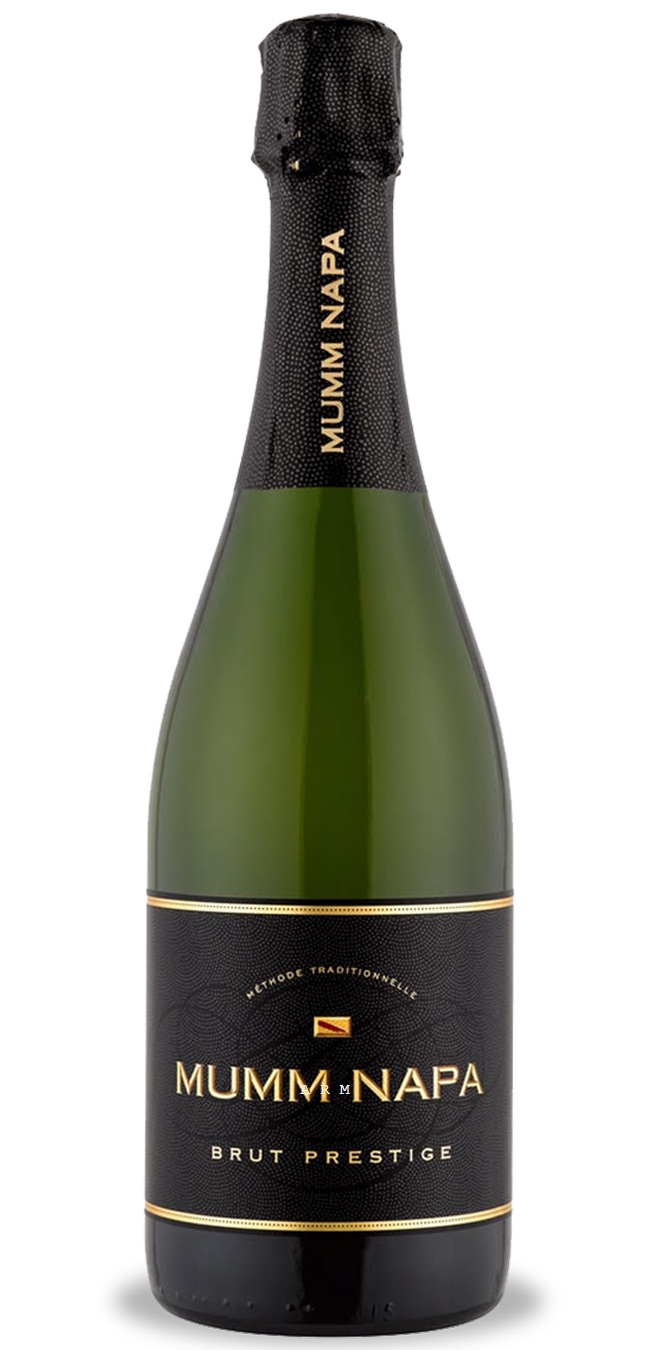 and aged in
a combination of American and French neutral oak
for a year prior to bottling. It has jammy flavors
of plums and strawberries,
with hints of cherry and a fresh finish. It makes
great accompaniment for spicy
wings as well as barbecued skirt steak.
and aged in
a combination of American and French neutral oak
for a year prior to bottling. It has jammy flavors
of plums and strawberries,
with hints of cherry and a fresh finish. It makes
great accompaniment for spicy
wings as well as barbecued skirt steak.
SPARKLERS
Mumm Napa Brut
Prestige Sparkling Wine
n.v ($24)‒Made from a blend of
hand-harvested grapes
(45% Chardonnay, 45% Pinot Noir and 20% Pinot
Meunier), this wine was fermented
mainly in stainless steel (with a small percentage
fermented in French oak
barrels), and a secondary fermentation (to produce
bubbles) over 18 months in
its bottle. It shows a bouquet and balanced taste
of apples and lemon with a
toasty finish. It mates well with simple hors
d’oeuvres like bruschetta and
smoked salmon on toast as well as sushi.
Sponsored by

Any of John Mariani's books below may be ordered from amazon.com.
 The Hound in Heaven
(21st Century Lion Books) is a novella, and
for anyone who loves dogs, Christmas, romance,
inspiration, even the supernatural, I hope you'll find
this to be a treasured favorite. The story
concerns how, after a New England teacher, his wife and
their two daughters adopt a stray puppy found in their
barn in northern Maine, their lives seem full of promise.
But when tragedy strikes, their wonderful dog Lazarus and
the spirit of Christmas are the only things that may bring
his master back from the edge of despair.
The Hound in Heaven
(21st Century Lion Books) is a novella, and
for anyone who loves dogs, Christmas, romance,
inspiration, even the supernatural, I hope you'll find
this to be a treasured favorite. The story
concerns how, after a New England teacher, his wife and
their two daughters adopt a stray puppy found in their
barn in northern Maine, their lives seem full of promise.
But when tragedy strikes, their wonderful dog Lazarus and
the spirit of Christmas are the only things that may bring
his master back from the edge of despair. WATCH THE VIDEO!
“What a huge surprise turn this story took! I was completely stunned! I truly enjoyed this book and its message.” – Actress Ali MacGraw
“He had me at Page One. The amount of heart, human insight, soul searching, and deft literary strength that John Mariani pours into this airtight novella is vertigo-inducing. Perhaps ‘wow’ would be the best comment.” – James Dalessandro, author of Bohemian Heart and 1906.
“John Mariani’s Hound in Heaven starts with a well-painted portrayal of an American family, along with the requisite dog. A surprise event flips the action of the novel and captures us for a voyage leading to a hopeful and heart-warming message. A page turning, one sitting read, it’s the perfect antidote for the winter and promotion of holiday celebration.” – Ann Pearlman, author of The Christmas Cookie Club and A Gift for my Sister.
“John Mariani’s concise, achingly beautiful novella pulls a literary rabbit out of a hat – a mash-up of the cosmic and the intimate, the tragic and the heart-warming – a Christmas tale for all ages, and all faiths. Read it to your children, read it to yourself… but read it. Early and often. Highly recommended.” – Jay Bonansinga, New York Times bestselling author of Pinkerton’s War, The Sinking of The Eastland, and The Walking Dead: The Road To Woodbury.
“Amazing things happen when you open your heart to an animal. The Hound in Heaven delivers a powerful story of healing that is forged in the spiritual relationship between a man and his best friend. The book brings a message of hope that can enrich our images of family, love, and loss.” – Dr. Barbara Royal, author of The Royal Treatment.
 |
The Encyclopedia of American Food and Drink by John F. Mariani (Bloomsbury USA, $35) Modesty forbids me to praise my own new book, but let me proudly say that it is an extensive revision of the 4th edition that appeared more than a decade ago, before locavores, molecular cuisine, modernist cuisine, the Food Network and so much more, now included. Word origins have been completely updated, as have per capita consumption and production stats. Most important, for the first time since publication in the 1980s, the book includes more than 100 biographies of Americans who have changed the way we cook, eat and drink -- from Fannie Farmer and Julia Child to Robert Mondavi and Thomas Keller. "This book is amazing! It has entries for everything from `abalone' to `zwieback,' plus more than 500 recipes for classic American dishes and drinks."--Devra First, The Boston Globe. "Much needed in any kitchen library."--Bon Appetit. |
"Eating Italian will never be the same after reading John Mariani's entertaining and savory gastronomical history of the cuisine of Italy and how it won over appetites worldwide. . . . This book is such a tasteful narrative that it will literally make you hungry for Italian food and arouse your appetite for gastronomical history."--Don Oldenburg, USA Today. "Italian
restaurants--some good, some glitzy--far
outnumber their French rivals. Many of
these establishments are zestfully described
in How Italian Food Conquered the World, an
entertaining and fact-filled chronicle by
food-and-wine correspondent John F.
Mariani."--Aram Bakshian Jr., Wall Street
Journal.
"Equal parts
history, sociology, gastronomy, and just
plain fun, How Italian Food Conquered the
World tells the captivating and delicious
story of the (let's face it) everybody's
favorite cuisine with clarity, verve and
more than one surprise."--Colman Andrews,
editorial director of The Daily
Meal.com. "A fantastic and fascinating
read, covering everything from the influence
of Venice's spice trade to the impact of
Italian immigrants in America and the
evolution of alta cucina. This book will
serve as a terrific resource to anyone
interested in the real story of Italian
food."--Mary Ann Esposito, host of PBS-TV's
Ciao
Italia. "John Mariani has written the
definitive history of how Italians won their
way into our hearts, minds, and
stomachs. It's a story of pleasure over
pomp and taste over technique."--Danny Meyer,
owner of NYC restaurants Union Square
Cafe, The Modern, and Maialino.
|
 |
 |
 |
 |
 |
 |
 |
 |
 Everett Potter's Travel Report:
Everett Potter's Travel Report: 
 Eating Las Vegas
JOHN CURTAS has been covering the Las Vegas
food and restaurant scene since 1995. He is
the co-author of EATING LAS VEGAS – The 50
Essential Restaurants (as well as
the author of the Eating Las Vegas web site: www.eatinglasvegas.
He can also be seen every Friday morning as
the “resident foodie” for Wake Up With the
Wagners on KSNV TV (NBC) Channel 3 in
Las Vegas.
Eating Las Vegas
JOHN CURTAS has been covering the Las Vegas
food and restaurant scene since 1995. He is
the co-author of EATING LAS VEGAS – The 50
Essential Restaurants (as well as
the author of the Eating Las Vegas web site: www.eatinglasvegas.
He can also be seen every Friday morning as
the “resident foodie” for Wake Up With the
Wagners on KSNV TV (NBC) Channel 3 in
Las Vegas.
MARIANI'S VIRTUAL GOURMET
NEWSLETTER is published weekly. Publisher: John Mariani. Editor: Walter Bagley. Contributing Writers: Christopher Mariani,
Robert Mariani, Misha Mariani, John A. Curtas, Gerry Dawes, Geoff Kalish,
and Brian Freedman. Contributing
Photographer: Galina Dargery. Technical
Advisor: Gerry
McLoughlin.
If you wish to subscribe to this
newsletter, please click here: http://www.johnmariani.com/subscribe/index.html
© copyright John Mariani 2020

